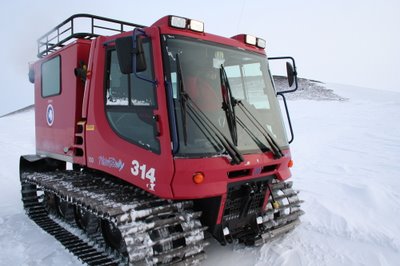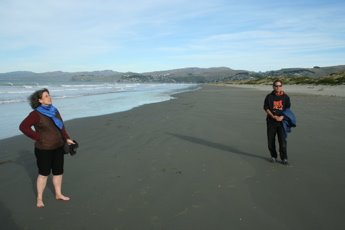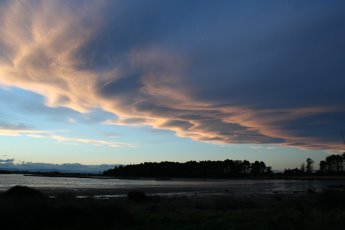Today we got up quite early and filmed a balloon launch. The "science group" we have been spending some time with fly helium balloons to take ozone readings and measure airborne particles. The balloons are made of .3mil plastic and are about thirty feet tall when inflated. A series of Rube Goldbergian devices, painted in multi-colored neon hues to facilitate later recovery, are suspended from the balloons in a chain; a GPS tracking device, an ozone data transmitter, the experiment which actually measures the ozone, a parachute. At the time the wind was only about five knots and the launch, although stressful, went off well. The balloon rose quickly into the black night sky and disappeared from view. As these balloons rise the helium within expands, finally bursting the balloon, at which point the parachute is meant to take over and ease the instrument back to the ground. This particular balloon made it about twenty five kilometers up before popping.In October, once the McMurdo helicopter pilots arrive, we will fly out and try to recover the remains of these experiments based on the last successfully received GPS coordinate transmission.
By mid-afternoon the conditions had turned quite nasty but we did some more filming outside nonetheless because we are men. Well, two of us are. It was minus seventeen degrees F and a fierce blow of about fifteen knots wind brought the windchill factor down to minus 37. We went out to film Phil training a couple of people on driving the Pickle, a relict forklift abandoned here by the Navy. After about forty minutes of wielding the boom in mighty brisk conditions I was certain that both of my thumbs would need to be removed and replaced, despite the chemical heat packs buried in my mittens. My wool balaclava had a chilly wet spot in the middle where I was exhaling, around which had formed an inflexible halo of ice. My beard and moustache were stiff and crackling and a sliver of exposed skin somewhere on my forehead seethed with pain. As soon as the pickle lesson was done we scampered back into the Crary laboratory, which houses our office. Total time outside was about one hour. I plugged in my 1200 watt hair dryer, toasted the balaclava dry and checked my email.
On March 14th, 1895 Fridtjof Nansen and Hjalmar Johansen abandoned their ship, the Fram somewhere in the frozen polar seas north of Siberia, and headed for the North Pole, either out of impatience or after some utterly unscientific determination that the icebound vessel would drift no closer. They took three sledges, thirty dogs, two bamboo kayaks, an odometer and a thermometer, some
pemmican and some fish-meal. The low that night was minus forty-five degrees F and Nansen has nothing to say about how they experienced the wind chill factor in their thin silk tent. They had with them their wolfskin oversuits but didn't wear them because they were "too warm" and collected perspiration during the day, only to freeze solid at night. Nansen wore primarily numerous layers of woolens.
"I cannot deny that it is a long journey, and scarcely any one has ever more effectually burned his boats behind him," he wrote. "If we wished to turn back we have absolutely nothing to return to, not even a bare coast. It will be impossible to find the ship, and before us lies the great unknown. But there is only one road, and that lies straight ahead, right through, be it land or sea, be it smooth or rough, be it mere ice or and water. And I cannot but believe that we must get through, even if we should meet with the worst--viz. land and pack-ice."
Nansen's projections of how long the journey might take read like the purest conjecture of an extreme optimist. Within days of leaving the Fram the duo were butting up against enormous icey pressure ridges which required long detours. The canvas coverings of the kayaks, useless on the solid, endless ocean of ice, were tattered and holed from various accidents with sharp protruding ice. The temperature was often far colder than that which we experienced today on our brief foray outside. At night they shivered in reindeerskin sleeping bags for hours before these solid sheathes of ice thawed enough for them to get to sleep.
After convincing himself that they were making good progress northwards but this progress was being counteracted by a sudden and persistent southward drift of the ice on which they were traveling, Nansen finally came to his senses on April 8th and determined that for them to have any chance of returning to any kind of land they needed to turn back without reaching the pole, but having achieved
"Farthest North." Summer was coming and the two men were in the middle of a frozen ocean that would shortly begin to thaw. They were, essentially, lost, since in the long brutal days of endlessly lugging their sledges over mountainous piles of shattered ice floes their watches had run down unwound and it was therefore impossible to take accurate navigational readings.
"Saturday, June 2nd [note that 8 WEEKS more of horrifying slogging have passed since the two turned back]. I could hardly have imagined that we should still be in the drift-ice without seeing land; but Fate wills otherwise, and she knows no mercy. The lane which stopped us yesterday did not close, but opened wider until there was a big sea to the west of us, and we were living on a floe in the midst of it without a passage across anywhere. So, at last, what we have so often been threatened with has come to pass: we must set to work and make our kayaks seaworthy."
Here at McMurdo I just finished my cafeteria meal of hot chicken "alfredo" along with some fresh lettuce, some of the last remaining from the last supply flight of Winfly. Afterwards I had some soft ice-cream with sprinkles. We bundle up in our three quarter length down coats to march the fifty yards from one heated building to another. I am about to go to bed, where I find my army-issue gray wool blanket a bit too warm. Compared to Fridtjof and Johansen and the rest of the Norwegian lads we will leave for now, still stranded on the ice, it is hard to conclude that we are anything more than a bunch of
pussies.



























